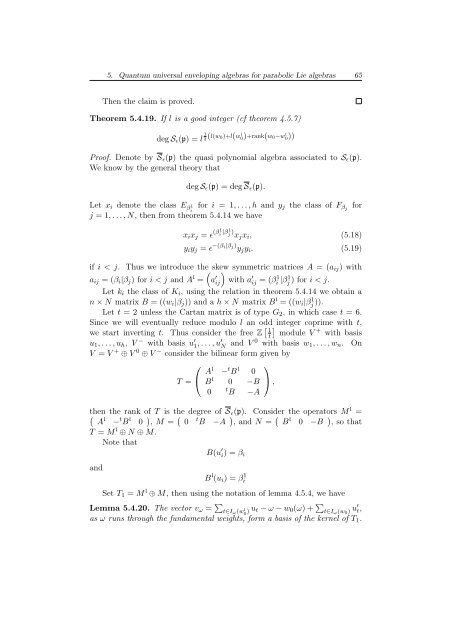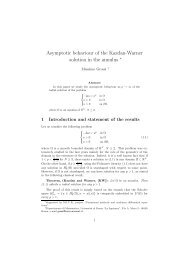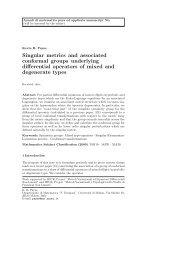Degree of Parabolic Quantum Groups - Dipartimento di Matematica ...
Degree of Parabolic Quantum Groups - Dipartimento di Matematica ...
Degree of Parabolic Quantum Groups - Dipartimento di Matematica ...
You also want an ePaper? Increase the reach of your titles
YUMPU automatically turns print PDFs into web optimized ePapers that Google loves.
5. <strong>Quantum</strong> universal enveloping algebras for parabolic Lie algebras 65<br />
Then the claim is proved.<br />
Theorem 5.4.19. If l is a good integer (cf theorem 4.5.7)<br />
deg Sǫ(p) = l 1<br />
2(l(w0)+l(w l 0)+rank(w0−w l 0))<br />
Pro<strong>of</strong>. Denote by Sǫ(p) the quasi polynomial algebra associated to Sǫ(p).<br />
We know by the general theory that<br />
Let xi denote the class E β 1 i<br />
deg Sǫ(p) = deg Sǫ(p).<br />
for i = 1, . . .,h and yj the class <strong>of</strong> Fβj for<br />
j = 1, . . .,N, then from theorem 5.4.14 we have<br />
xixj = ǫ (β1 i |β1 j ) xjxi, (5.18)<br />
yiyj = ǫ −(βi|βj) yjyi. (5.19)<br />
if i < j. Thus we introduce the skew symmetric matrices A = (aij) with<br />
aij = (βi|βj) for i < j and Al <br />
= a ′ <br />
ij<br />
with a ′ ij = (β1 i |β1 j ) for i < j.<br />
Let ki the class <strong>of</strong> Ki, using the relation in theorem 5.4.14 we obtain a<br />
n × N matrix B = ((wi|βj)) and a h × N matrix Bl = ((wi|β1 j )).<br />
Let t = 2 unless the Cartan matrix is <strong>of</strong> type G2, in which case t = 6.<br />
Since we will eventually reduce modulo l an odd integer coprime with t,<br />
we start inverting t. Thus consider the free Z <br />
1 module V + with basis<br />
t<br />
u1, . . .,uh, V − with basis u ′ 1 , . . .,u′ N and V 0 with basis w1, . . .,wn. On<br />
V = V + ⊕ V 0 ⊕ V − consider the bilinear form given by<br />
⎛<br />
T = ⎝<br />
A l − t B l 0<br />
B l 0 −B<br />
0 t B −A<br />
then the rank <strong>of</strong> T is the degree <strong>of</strong> Sǫ(p). Consider the operators M l =<br />
A l − t B l 0 , M = 0 t B −A , and N = B l 0 −B , so that<br />
T = M l ⊕ N ⊕ M.<br />
Note that<br />
and<br />
B(u ′ i) = βi<br />
B l (ui) = β 1 i<br />
Set T1 = Ml ⊕ M, then using the notation <strong>of</strong> lemma 4.5.4, we have<br />
Lemma 5.4.20. The vector vω = <br />
t∈Iω(wl 0 ) ut − ω − w0(ω) + <br />
t∈Iω(w0) u′ t,<br />
as ω runs through the fundamental weights, form a basis <strong>of</strong> the kernel <strong>of</strong> T1.<br />
⎞<br />
⎠,








